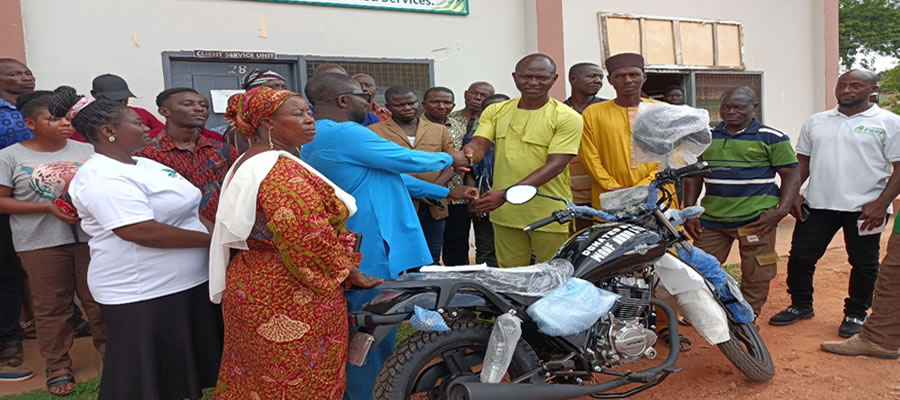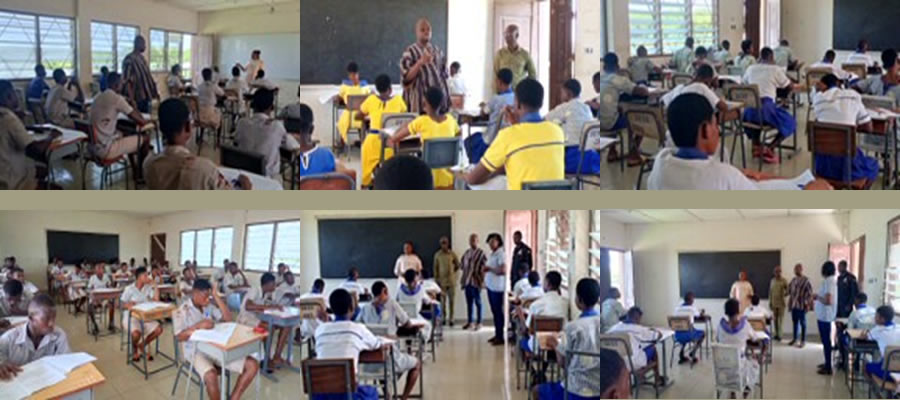

Population Size and Growth Rate
The District has a population of 93,600 with a relatively high growth rate of 3.0% as above the national growth rate of 2.7%. Out of this population figure, males account for 45,864 and females 47,736. The entire population of the district constitutes about 0.4% of the National average of about 21,607,077. The relatively high growth rate in the district is likely to be the influx of migrant farmers from the northern parts of the country.
Spatial Distribution of Population
The District has about 122 communities. However, some of them have a population of less than 100 people and can thus be described as hamlets and villages. There is only one community which has its population above 5,000 and thus can be classified as urban (when urban is defined as settlement with population above 5,000), i.e. Jema, the District capital. The population of the District is fairly distributed. As a result, there is no heavy concentration in a particular area.
Population Density
The district has a population density of 53 persons per square kilometre as compared to the Regional figure of 44 persons per square kilometre.
Household Composition
The Longman Dictionary of Contemporary English defines household as “all the people living together in a house”. The socio-economic survey of 2006 revealed that households in the district are large. About 51% of households have members between 3 and 5; a household with between 6 and 8 members constitute 33% and those with 9 members and above is 14%.
Household with members of 1 and 2, constitute just 2%. This phenomenon reveals that most couples in the district do not adopt family planning methods in their sex lives. There could therefore be the need for stepping up the family planning education in the district. Most household heads in the district are males constituting 72% and females 28%. Interestingly, about 80% of the household heads are in the active population.
This means that 20% of household heads are dependent on the rest of the members. This situation could imply that most households are catered for in terms of their basic needs (as most household heads are employable). This is a positive contribution to building a strong and prosperous society, (as healthy households build a healthy society). The bigger household size is likely to be as a result of the settler farmers who prefer staying together as one family unit for a while before separating from their kinsmen. In some cases, they do not separate at all.
Rural-Urban Split
The District is basically a rural one with 99% of the population living in the rural areas whilst the remaining 1% of the population lives in settlement with population above 5000. About 30% of the population are settler farmers who migrated from the northern parts of the country. Some of the major settlements are located along the major Trunk road, which links Kintampo to Techiman.
Population by Settlement (Spatial Distribution)
The District contains over 122 settlements, with most of the major settlements located along the main roads of the District. Jema, the District Capital, was the only urban settlement in 2000 and with a population of 5,377 (2000 Population Census). The rest of the settlements were rural. To date most of the communities have still not attained the urban status with their populations of less than 5,000. Table 1.1 throws more light on the situation.
This movement of large number of people to the urban area could be ascribed to the attraction of social amenities in the Capital. This shows the need of the District Assembly to give serious consideration to providing social infrastructure in the rural areas of the district, otherwise in the short, time labour will be lacking in the rural areas of the district and that would impact negatively on the supply of food and cash crop.
Environmental Situation
This section presents the existing situation or status of development of the District after the implementation of the GPRS I. The various areas of developmental concern have been analysed to find out the development gaps that need to be closed under the 2006 – 2009 development plan.
Environmental Situation
The environmental situation of the district consists of the natural environment, conditions of the built environment as well as sites of historic and aesthetic importance.
Conditions of the Natural Environment
The district has an extensive forest reserve of about 150.50km2 known as the Bosomoa Forest Reserve. The tree species found in the reserves include, Teak, Odum, Wawa, Senya, Manana and Mahogany, which have given rise to timber extraction. These reserves can be found in the areas around: Krutakyi, Jema, Ampoma, Anyima, Nante and Krabonso. The activities of timber contractors, illegal chain saw operators and the use of traditional farming methods, such as slash and burn, have contributed negatively to the changing face of the natural environment. The consequences are as follows:
Depletion of the economic trees and the forest reserves as a result of the neglect of afforestation and re-afforestation programmes and the destruction of young trees, all leading to microclimate change and ecological imbalance as well as changing of the forest vegetation to that of grassland and savanna.
Destruction of crops through indiscriminate felling and transportation of the extracted timber from the bush.
The high incidence of bush fires in the district, especially in the dry season, which are mainly caused by group hunting, indiscriminate burning of farm lands without creating fire belts by farmers, failure to seek fire volunteer assistance during burning and careless handling of faggots by palm wine tappers have left most of the farming land bare and exposed to erosion, which is rapidly destroying the natural vegetation and altering the ecology of the district.
However, according to the National Fire Service, the bush fires in the year 2005/2006 were brought to the barest minimum with only few incidences. This low prevalence of bush fires in 2005/2006 is attributed to the Anti-Bush fire campaigns carried out by the National Fire Service in collaboration with the District Assembly. If this practice is sustained, the forest would be regenerated in a few years. The forest is not only important for growing food crops, but also an important source of fuel wood and charcoal.
Fuel wood and charcoal are the main sources of energy for cooking in the households, constituting 65% and 25% respectively of domestic energy consumption. A survey conducted revealed that about 61% of the energy used in the district is supplied or exploited from the forest. This situation contributes to the depletion of the tree species, and thus calls for reaforestation projects, as currently taking place intensively in the district by the Department of Forestry.
The well-drained soil can support cash crops such as cashew, mangoes and others. Food crops like maize, cassava, and vegetables also do well in the district.
Infrastructure Distribution and Service Levels
The quality and quantity of economic infrastructure within an economy is vital for development. The current economic infrastructure situation in the District.
Human Settlement Patterns
Human settlement pattern is informed by factors, which are related to economic, social, historical, and other factors. The district space economy becomes clearer with the analysis of its settlement pattern and spatial linkages. This study leads us to understand the functions performed by settlements and their hierarchy, which the centrality indices are used to assess.
An examination of the settlement pattern was carried out to find the distribution of economic and social facilities in the district (see table ). The relatively larger settlements, with a population of above 1000, which are on table …., have also been put on the scalogram. A scalogram is a matrix of the functional arrangement of settlements.
In the scalogram, 30 number of services were considered in all the 29 settlements. The hierarchy of settlements was derived from the centrality indices. Five levels of functional hierarchy were derived. Only Jema , with a population of 7,868, emerged as the first (1st) order settlement in the district having 26 of the services. Anyima emerged the second order (2nd) settlement with 16 services.
Three settlements emerged as the third (3rd) order settlements, with the rest of the settlements as fourth (4th) and fifth (5th) orders with centrality index less than 20. The important point to consider in the analysis is to ensure balance or equity in space. To this, therefore, all settlements which have attained a minimum population threshold to get an appropriate facility, should be provided.
For example towns with population 5000 and above, which qualify for Urban Development projects, should be provided with projects and services to enable them to play key functions for the people. The development strategy must therefore be focussed on the creation of hierarchically structured spatial system in which linkages between its components are strengthened.
To achieve a balanced development, emphasis should be on the growth of second order and third order settlements as rural centres in order to provide services like storage facilities, market as well as labour intensive industries for the processing of local materials.
Date Created : 11/17/2017 1:21:10 AM











 facebook
facebook
 twitter
twitter
 Youtube
Youtube
 +233 593 831 280
+233 593 831 280 0800 430 430
0800 430 430 GPS: GE-231-4383
GPS: GE-231-4383 info@ghanadistricts.com
info@ghanadistricts.com Box GP1044, Accra, Ghana
Box GP1044, Accra, Ghana